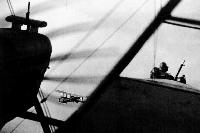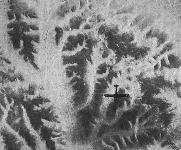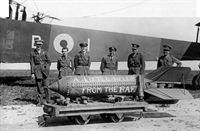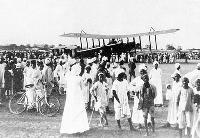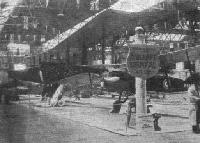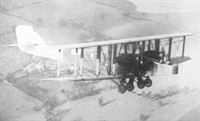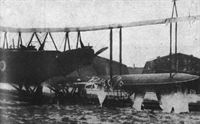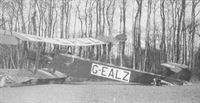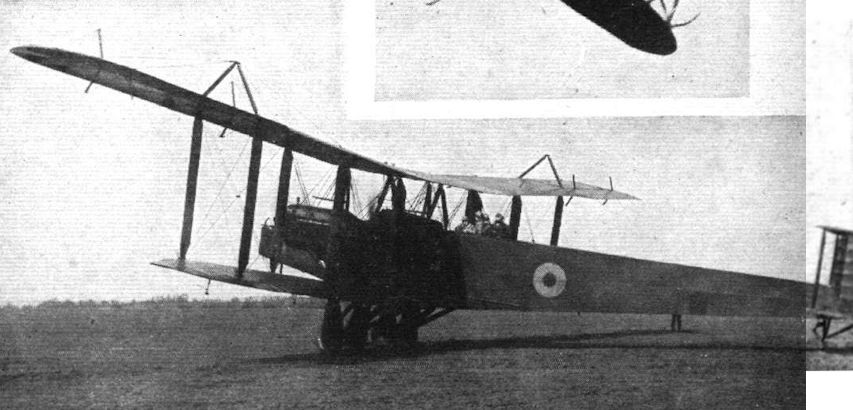
Описание
Страна : Великобритания
Год : 1917
Тяжелый бомбардировщик с экипажем из четырех-пяти человек
Варианты
- Handley Page - H.P.11 (O/100) - 1915 - Великобритания
- Handley Page - H.P.12 (O/400) - 1917 - Великобритания
- Handley Page - O/7 / O/10 / O/11 - 1919 - Великобритания
Handley Page Н.P.11 и Н.P.12 (Types O/100 и O/400)
<...>
В начале 1918 года начались поставки серийных самолетов Type O/400 (позднее H.P.12) - улучшенной версии Type O/100 с более мощными моторами Eagle. Цифра в названии теперь означала не размах крыла, а мощность двигателя. Моторы этой машины впервые получили пневмостартеры. Хотя серийно выпустили лишь 46 экземпляров O/100, в боях участвовало довольно много бомбардировщиков O/400. Например, в ночь с 14 на 15 сентября 1918 года группа из 40 Type O/400 нанесла массированный удар по объектам в Сааре. Эти аэропланы могли сбрасывать 748-кг бомбы, самые тяжелые из применявшихся британцами в Первой мировой войне.
До заключения перемирия в ноябре 1918 года на вооружение британских ВВС поступило свыше 400 аэропланов Type O/400. Ими оснастили 58-ю, 97-ю, 115-ю, 207-ю, 214-ю, 215-ю и 216-ю эскадрильи. Самолет оставался на вооружении до конца 1919 года, когда его сменил бомбардировщик Vickers Vimy. Восемь таких аэропланов использовались в 86-м авиакрыле, сформированном в Хендоне в декабре 1918 года для перевозок правительственных и военных деятелей между Лондоном и Парижем. В 214-й эскадрилье этот тип использовался для перевозки авиапочты. В США планировалось построить до 1500 аэропланов Type O/400, но до конца войны американская фирма "Standard Aircraft" успела выпустить всего 107, после чего заказ аннулировали. Американские машины оснащались моторами Liberty.
<...>
ТАКТИКО-ТЕХНИЧЕСКИЕ ХАРАКТЕРИСТИКИ
Handley Page Type O/400
Тип: тяжелый бомбардировщик с экипажем из четырех-пяти человек
Силовая установка: два V-образных ПД Rolls-Royce Eagle VIII мощностью по 360 л. с. (268 кВт)
Летные характеристики: максимальная скорость 156 км/ч на уровне моря; набор высоты 1980 м за 27 мин 10 с; практический потолок 2590 м; продолжительность полета 8 ч
Масса: пустого 3719 кг; максимальная взлетная 6350 кг
Размеры: размах крыла 30,48 м; длина 19,15 м; высота 6,71 м; площадь крыльев 153,10 м2
Вооружение: один либо два подвижных стреляющих вперед 7,7-мм пулемета Lewis в носовой стрелковой точке, один либо два подвижных стреляющих назад пулемета Lewis в надфюзеляжной точке и один подвижный стреляющий назад пулемет Lewis в подфюзеляжной точке, плюс до 907 кг боевой нагрузки в фюзеляжном отсеке вооружения и на двух подфюзеляжных узлах подвески
- Описание
Фотографии
-
Мировая Авиация 23
Handley Page О/400
-
Мировая Авиация 100
Регистрационный номер: D4563 Handley Page O/400. Данный самолет принадлежал 207-й эскадрилье, базировавшейся во французском Лижескуре. Это была первая эскадрилья, полностью сосредоточенная на стратегических бомбардировках.
-
Мировая Авиация 148
Хотя фирма "Standard Aircraft" из штата Нью-Джерси по контракту поставляла части для британских серийных бипланов O/400, фактически эта компания построила в Америке семь самолетов с моторами Liberty. Эта машина в 1919 году участвовала в испытаниях по сбросу 907-кг бронебойных бомб.
-
Flight 1939-06 / Flight
Known as the O/400, the large bomber laid the real foundation of the greatness of the house of Handley Page.
The first British twin-engined bomber, the Handley Page O/400, had two Rolls-Royce "Eagle" engines of 360 h.p. each. This type did not come into service until near the end of the war. This type was to have been used for bombing Berlin, but the Armistice intervened. -
Aeroplane Monthly 1995-08 / Personal album. Military
Регистрационный номер: B8802 This Handley Page O/400, B8802, was the first of a batch of 12 built at RAE Farnborough. It arrived at Martlesham Heath for performance trials on July 18, 1918; these were completed by August 10, but the aircraft remained there for further trials. These ended by August 31, and B8802 went to Orfordness on September 7. On June 30, 1919, it was flown to Grain via Rochford.
-
Aeroplane Monthly 1974-12 / Personal album
A Handley Page O/400, probably serving with the RAF. It carries an additional fuel tank on the top fuselage decking beneath the centre section. Mr Woollett's grandfather is standing in the upper rear cockpit.
-
Aeroplane Monthly 1980-02 / Personal album
Регистрационный номер: D9689 Handley Page O/400 D9689, built in Lincoln by Clayton & Shuttleworth Ltd, surrounded by both RAF and United States Air Service personnel (note hats of the latter). Power was provided by a pair of 360 h.p. Rolls-Royce Eagle VIIIs
-
Aeroplane Monthly 1983-11 / L.Coombs - Cockpits of the RAF (2)
Регистрационный номер: B8811 This shot of Handley Page O/400 B8811 shows the cockpit area projecting out in front of the wings and propellers.
-
Мировая Авиация 100
Основным бомбардировщиком созданных в апреле 1918 года Королевских ВВС Великобритании был Handley Page O/400. Иногда в ночной налет на Германию отправлялись до 40 самолетов O/400.
Handley Page O/400s go into action. -
Flight 1920-09 / Flight
Over the Egyptian desert, showing a plan view of a Handley Page in the mid-distance. Note the scrubby shrubs which dot the water-gullies in the sand
-
Flight 1923-07 / Flight
THE R.A.F. PAGEANT: A Handley Page O.400 brings an eventful day's proceedings to a close with final "Brock's Benefit," by discharging artificial cloud-screen bombs.
-
Flight 1921-07 / Flight
EVENT 9 AT THE PAGEANT: The attack on three Handley Page bombers by five Snipes. In the first picture the latter are seen swooping down and firing their guns, and below two of the Handley Pages are sent down "in flames." To the left Mr. Newel "escapes" from the third Handley Page, and to make certain, uses three parachutes!
Другие самолёты на фотографии: Sopwith Snipe / 7F.1 - Великобритания - 1918
-
Мировая Авиация 148
Бомбардировщик Type O/400 выделялся своими размерами. Он мог поднять одну 748-кг бомбу, либо три бомбы по 249 или 236 кг, либо восемь бомб по 113-кг, либо 16 бомб по 51 кг на внутренней подвеске, а также две бомбы на внешней подвеске.
-
Мировая Авиация 23
Снимок дает наглядное представление о гигантских размерах О/400. Самолет принадлежит 207-й эскадрилье, аэродром Линжескур, Франция. 207-я (ранее - 7-я) эскадрилья первой получила самолеты Handley Page и она же первой приступила к дальним ночным рейдам на германскую территорию.
-
Aeroplane Monthly 1989-07 / Personal album. Military
Регистрационный номер: C9704 This O/400, C9704 was probably accepted late in July 1918. With wings folded, the overall width of the O/400 was reduced to 31ft; the full extended span was 100ft. Just ahead of the lower centre section can be seen the crew entry hatch: it bears the cautionary notice “Keep clear of the propellers".
-
Flight 1921-07 / Flight
FROM THE AERIAL PAGEANT IN EGYPT: Some of the Handley Pages which performed the function of char-a-bancs admirably although having seen service at the front.
-
Aeroplane Monthly 1989-07 / P.Jarrett - Austin's Aerial Nippy
Регистрационный номер: J2251 First Austin Whippet is standing alongside Handley Page O/400 J2251, one of a batch built by the Birmingham Carriage Co Ltd. This aircraft also joined the civil register, becoming HP-21/G-EALX with Handley Page Transport Ltd in October 1919, but was scrapped after a heavy landing in April 1921. Engines were two 360 h.p. Rolls-Royce Eagle VIIIs, which drove a pair of four-bladed propellers.
Другие самолёты на фотографии: Austin Whippet - Великобритания - 1919
-
Aeroplane Monthly 1979-06 / Personal album
Регистрационный номер: D9703 Sopwith 1F.1 Camel C8, one of a batch of 200 built by the Nieuport and General Aircraft Co Ltd, is dwarfed by Handley Page O/400 D9703, constructed by Clayton & Shuttleworth Ltd of Lincoln.
Другие самолёты на фотографии: Sopwith Camel / F.1 - Великобритания - 1916
-
Aeroplane Monthly 1985-04 / Personal album
Регистрационный номер: C9639 A more fortunate Handley Page O/400, C9639. This aircraft was the fourth Handley Page-built production O/400, from the initial batch of 150.
-
Aeroplane Monthly 1989-07 / Personal album. Military
Регистрационный номер: D8311 The batch of 50 O/400s numbered D8301 - D8350 was originally ordered from the British Caudron company, but the serial numbers were subsequently allotted to Handley Page Ltd, who assembled the aircraft from parts made by British Caudron and Harris Lebus. D8311 was completed in late August 1918, and was sent to France for use by the Independent Force, RAF; it arrived there on September 27, and moved to No 3 Aircraft Depot on September 29.
-
Air Pictorial 1958-07 / Scrapbook
The U.S. Army Air Service took delivery of 107 Standard (Aircraft Corp.)-built O/400s from September 1918 onwards. These 100-ft. span "Night Bombardment-Short Range, Type XII" bombers were powered by two 350-h.p. Liberty 12-Ns.
-
Aeroplane Monthly 1979-08 / Cricklewood /Gone but not forgotten/ (4)
Регистрационный номер: C9715 [2] H.P. O/400 C9715 at Cricklewood in 1918. This aircraft was demonstrated to Canadian journalists at Hendon in August that year.
-
Aeroplane Monthly 1989-07 / Personal album. Military
Регистрационный номер: C9715 [2] This O/400, C9715, was one of the first production batch ordered from Handley Page Ltd under Contract No A.S. 27644. It was probably delivered early in August 1918, but it seems to have gone to France.
-
Мировая Авиация 75
Хотя согласно контракту американская фирма "Standard Aircraft" должна была поставлять в Британию только части для сборки, семь 0/400 с моторами Liberty были построены в США. На снимке первый из этих самолетов, получивших имя Langley. В опытах, проведенных генералом Митчеллом, было доказано, что самолет может уничтожить военный корабль - один 0/400 добился прямого попадания в трофейный немецкий линкор "Остфрисланд", а позже с него была сброшена 1814-кг бомба.
-
Мировая Авиация 23
HP О/400 - один из бомбардировщиков, которые американец Билли Митчелл использовал в экспериментальных бомбометаниях по трофейному германскому линкору "Ост-фрисланд"в 1921 году. Успешные результаты испытаний положительно сказались на развитии американской бомбардировочной авиации.
-
Aviation Historian 23 / G.Baughen - New model Air Force
Надпись на бомбе - "маленький ад, подарок от RAF" - ранний исторический пример "дарственных" надписей на авиационных средствах поражения. Такие надписи всегда поднимали боевой дух войск.
Members of No 207 Sqn RAF pose beside one of the unit’s Handley Page O/400 bombers, about to be fitted with a gift for the Kaiser, an 1,800lb SN bomb with a personal inscription, at Ligescourt, near Abbeville, in August 1918. Development of a strategic bomber force was to become the central focus of the post-war RAF. -
Aeroplane Monthly 1986-02 / J.Stroud - Wings of Peace
Регистрационный номер: D8326 The Handley Page O/400 D8326 H.M.A.L. Silver Star, with wings folded.
-
Aeroplane Monthly 1979-08 / R.Halley - The Kabul Raid
Регистрационный номер: C9700 [3] H.P. O/400 C9700 at Serny, France, en route to India.
-
Мировая Авиация 75
O/400 несли службу на Ближнем Востоке с весны 1919 года до начала 1920-х годов. В их задачу входили проведение полицейских операций против враждебных арабских племен и поставка снаряжения и топлива на различные аэродромы.
-
Мировая Авиация 34
12 декабря 1918г.: самолет Handley Page О/400 с экипажем в составе Бортона, Сэлмонда и Смита, проводивший разведку трассы для почтовой авиалинии между Египтом и Индией, прибыл в Дели.
-
Aeroplane Monthly 1989-09 / L.James - Policing the Empire
Регистрационный номер: C9700 [3] Large Handley Page bombers rarely failed to impress during their Empire visits. This O/400, C9700, pioneered the air route from England to Delhi, arriving on December 12, 1918. On May 24 the following year another Handley Page, V/1500 J1936, ended an Afghan revolt led by Amir Amanullah by bombing his fortress at Kabul
-
Flight 1920-01 / Flight
The crew of the Handley Page (type O-400) which recently flew from London to Warsaw. Capt. Herne is seen standing immediately under the nose of the fuselage, and on his left is Capt. McNaught Davis. This is the machine which it was said was chased by German air guards when flying from Cologne to Berlin
-
Aviation Historian 8 / F.Merriam - "Better to be Born Lucky than Rich..." /Echoes from Dawn Skies/ (3)
During 1916-18 Lankester Parker was a test pilot for the London-based Prodger-lsaac Aviation Co. Here Clifford Prodger (left) and Bernard Isaac pose beside a Handley Page O/400 bomber circa 1918.
-
Air Enthusiast 1995-09 / J.Godwin - Wings to the Cape
Регистрационный номер: G-EAMC [2] The Handley Page O/400 G-EAMC at Assiut, Egypt.
-
Air Pictorial 1956-07 / B.Robertson - U.S. Aircraft in the British Services 1914-1955 (1)
Регистрационный номер: F5349 F5349, the first Handley Page O/400 built in America for the R.F.C., is shown in this photograph being assembled In England.
-
Flight 1920-07 / Flight
The Aircraft Disposal Company's Exhibit at the Aero Show, Olympia: A Bristol Fighter and Handley Page Bomber.
Другие самолёты на фотографии: Bristol F.2A/F.2B Fighter - Великобритания - 1916
-
Aeroplane Monthly 1977-12 / Personal album
Регистрационный номер: C9713 A rare photograph of Handley Page O/400 C9713 after modification to W/400 standard, with a new set of wings and new, clear-doped, tail of the type later to become standard on the W.8 airliner. Trials were carried out at Martlesham, Farnborough and Cricklewood, and C9713 was finally taken out of service in July 1920. This aircraft never bore a civil registration and remained the property of the Air Ministry, although it was on loan to Handley Page during the trials.
-
Flight 1921-06 / Flight
LONDON-PARIS FROM THE AIR: Off to Paris. A snap, taken on board a Handley Page aeroplane, when in flight for Paris, of pilot Lieut. Macintosh and his engineer.
-
Aeroplane Monthly 1977-02 / Personal album
Регистрационный номер: D8340 Handley Page O/400 D8340 after a cross-wind landing at Castle Bromwich in March 1919. Miraculously the pilot and five passengers escaped unhurt. This O/400 was built by the British Caudron Co at Cricklewood and had a pair of 360 h.p. Rolls-Royce Eagle VIII engines.
-
Flight 1938-03 / Flight
A war-time memory ot No. 214 Squadron, or, as it was then, No. 5 Wing, R.N.A.S., later divided into No. 7 and No. 14 Squadrons. The picture shows a O/400 Handley Page safely home after being “winged” by anti-aircraft fire.
-
Aeroplane Monthly 1988-02 / Personal album. Civil
Регистрационный номер: G-EALZ, J2243 Handley Page H.P.12 G-EALZ, ex J2243, was registered to Handley Page Ltd in December 1919 and operated by Handley Page Transport Ltd until withdrawn from service that December.
-
Air Enthusiast 1995-09 / J.Godwin - Wings to the Cape
Регистрационный номер: G-EAMC [2] The wreck of Handley Page south of Wadi Halfa.
-
Aeroplane Monthly 1979-08 / R.Halley - The Kabul Raid
Регистрационный номер: C9700 [3] Three views of the wrecked H.P. O/400 C9700 at Risalpur in April 1919.
-
Aeroplane Monthly 1985-04 / Personal album
Регистрационный номер: D9687 [2] Personnel from Tern Hill pose nonchalantly with the remains of Handley Page O/400 D9687.
-
Aeroplane Monthly 1985-04 / Personal album
More unhappy Handley Pages: the identity of the O/400 is unknown, although other photographs of the same crash show that it bore night-bombing markings.
-
Aeroplane Monthly 1985-04 / Personal album
Регистрационный номер: D9687 [2] Another view of the wreckage of D9687, one of a batch of O/400s ordered from Clayton & Shuttleworth of Lincoln in January 1918. The “eggbox” bomb bay, which could accommodate up to 16 112lb bombs, is clearly seen. The arrow-shaped hole in the fuselage underside aft of the wings is a gun position, from which a single Lewis fired downwards and backwards.
-
Flight 1920-01 / Flight
A NIGHT LANDING: An Impression by Charles Dixon, R.I., of a Handley Page biplane landing on an aerodrome after dark.
- Фотографии








